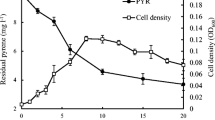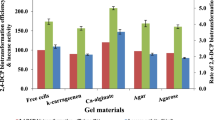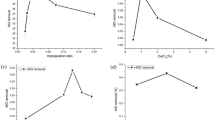Abstract
In this study, it was the first report that the Brevibacterium lutescens CCZU12-1 was employed as a sulfur removing bacteria. Using dibenzothiophene (DBT) as the sole sulfur source, B. lutescens could selectively degrade DBT into 2-hydroxybiphenyl (2-HBP) via the “4S” pathway. In the basal salt medium (BSM) supplemented with 0.25 mM DBT and 0.5 g/L Tween-80, high desulfurization rate (100 %) was obtained by growth cells after 60 h. Furthermore, the n-octane–water (10:90, v/v) biphasic system was built for the biodesulfurization by resting cells. Moreover, a combination of magnetic nano Fe3O4 particles with calcium alginate immobilization was used for enhancing biodesulfurization. In this n-octane–water biphasic system, immobilized B. lutescens cells could be reused for not less than four times. Therefore, B. lutescens CCZU12-1 shows high potential in the biodesulfurization.





Similar content being viewed by others

References
Wang, Z., & Stout, S. (2007) Elsevier/Academic Press, Amsterdam; Boston, MA.
Zhang, T., Li, W. L., Chen, X. X., Tang, H., Li, Q., Xing, J. M., & Liu, H. Z. (2011). World Journal of Microbiology and Biotechnology, 27, 299–305.
Teixeira, A. V., Paixão, S. M., da Silva, T. L., & Alves, L. (2014). Applied Biochemistry and Biotechnology. doi:10.1007/s12010-014-0902-6.
Alves, L., Salgueiro, R., Rodrigues, C., Mesquita, E., Matos, J., & Gärio, F. M. (2005). Applied Biochemistry and Biotechnology, 120, 199–208.
Li, Y. G., Xing, J. M., Xiong, X. C., Li, W. L., Gao, H. S., & Liu, H. Z. (2008). Journal of Industrial Microbiology and Biotechnology, 35, 145–150.
Yu, B., Xu, P., Shi, Q., & Ma, C. (2006). Applied and Environmental Microbiology, 72, 54–58.
Alves, L., & Paixão, S. M. (2014). Applied Biochemistry and Biotechnology, 172, 3297–3305.
Jiang, X., Yang, S. L., & Li, W. L. (2014). Applied Biochemistry and Biotechnology, 172, 62–72.
Bardania, H., Raheb, J., Mohammad-Beigi, H., Rasekh, B., & Arpanaei, A. (2013). Biotechnology and Applied Biochemistry, 60(3), 323–329.
Constanti, M., Giralt, J., & Bordons, A. (1996). Enzyme and Microbial Technology, 19, 214–219.
Gilbert, S. C., Morton, J., Buchanan, S., Oldfield, C., & McRoberts, A. (1998). Microbiology, 144, 2545–2553.
Konishi, J., Onaka, T., Ishii, Y., & Suzuki, M. (2000). FEMS Microbiology Letters, 187, 151–154.
Tanaka, Y., Onaka, T., Matsui, T., Maruhashi, K., & Kurane, R. (2001). Current Microbiology, 43, 187–191.
Izumi, Y., Ohshiro, T., Ogino, H., Hine, Y., & Shimao, M. (1994). Applied and Environmental Microbiology, 60, 223–226.
He, Y. C., Ma, C. L., Yang, Z. X., Zhou, M., Xing, Z., Ma, J. T., & Yu, H. L. (2013). Applied Microbiology and Biotechnology, 97, 10329–10337.
He, Y. C., Zhou, Q., Ma, C. L., Cai, Z. Q., Wang, L. Q., Zhao, X. Y., Chen, Q., Gao, D. Z., Zheng, M., Wang, X. D., & Sun, Q. (2012). Bioresource Technology, 115, 88–95.
Dinamarca, M. A., Rojas, A., Baeza, P., Espinoza, G., Ibacache-Quiroga, C., & Ojeda, J. (2014). Fuel, 16, 237–241.
Gunam, I. B., Yamamura, K., Sujaya, I. N., Antara, N. S., Aryanta, W. R., Tanaka, M., Tomita, F., Sone, T., & Asano, K. (2013). Journal of Microbiology and Biotechnology, 23(4), 473–482.
Bardania, H., Raheb, J., Mohammad-Beigi, H., Rasekh, B., & Arpanaei, A. (2013). Biotechnology and Applied Biochemistry, 60(3), 323–329.
Gunam, I. B., Yamamura, K., Sujaya, I. N., Antara, N. S., Aryanta, W. R., Tanaka, M., Tomita, F., Sone, T., & Asano, K. (2013). Journal of Microbiology and Biotechnology, 23(4), 473–482.
Li, Y. G., Gao, H. S., Li, W. L., Xing, J. M., & Liu, H. Z. (2009). Bioresource Technology, 100(21), 5092–5096.
Li, F., Xu, P., Feng, J., Meng, L., Zheng, Y., Luo, L., & Ma, C. (2005). Applied and Environmental Microbiology, 71(1), 276–281.
Wu, S., Lin, J., & Chan, S. I. (1994). Applied Biochemistry and Biotechnology, 47(1), 11–20.
He, Y. C., Ma, C. L., Zhang, X., Li, L., Xu, J. H., & Wu, M. X. (2013). Applied Microbiology and Biotechnology, 97, 7185–7194.
Ohshiro, T., Hirata, T., & Izumi, Y. (1996). FEMS Microbiology Letters, 142, 65–70.
Tao, F., Yu, B., & Xu, P. (2006). Applied and Environmental Microbiology, 72, 4604–4609.
He, Y. C., Xu, J. H., Su, J. H., & Zhou, L. (2010). Applied Biochemistry and Biotechnology, 160, 1428–1440.
Ngo-Thi, M. T., Yin, J. G., Pan, J., Zheng, G. W., & Xu, J. H. (2013). Applied Biochemistry and Biotechnology, 170, 1974–1981.
He, Y. C., Pan, X. H., Xu, X. F., & Wang, L. Q. (2014). Applied Biochemistry and Biotechnology, 172, 3223–3233.
Acknowledgments
This work was financially supported by the National Natural Science Foundation of China (21102011), the Natural Science Fund for Colleges and Universities in Jiangsu Province (13KJB430025), the Environmental Protection Scientific Research in Jiangsu Province (2013004), the Fund of Key Laboratory for Advanced Technology in Environmental Protection of Jiangsu Province (AE201118), and the Industrial Technology Support Project in Yancheng City (2013).
Author information
Authors and Affiliations
Corresponding author
Rights and permissions
About this article
Cite this article
Dai, Y., Shao, R., Qi, G. et al. Enhanced Dibenzothiophene Biodesulfurization by Immobilized Cells of Brevibacterium lutescens in n-Octane–Water Biphasic System. Appl Biochem Biotechnol 174, 2236–2244 (2014). https://doi.org/10.1007/s12010-014-1184-8
Received:
Accepted:
Published:
Issue Date:
DOI: https://doi.org/10.1007/s12010-014-1184-8



